by Melanie Taylor | Aug 5, 2017

Most of us are willing to go to the doctor or the dentist, which are both part of taking care of our health. However, do you go to the eye doctor? If not, you definitely should add it to your healthy lifestyle regime. Eye exams at every age and stage of life can help you keep your vision strong. August is National Eye Exam month; this is the perfect reminder to schedule a comprehensive eye exam.
The Vision Council of America reports that 12.2 million Americans require some sort of vision correction, but do not use any. Nearly 50% of parents with children under 12 have never taken their children to an eye-care professional.
Many people think their eyesight is just fine, but then they get that first pair of glasses or contact lenses and the world becomes much clearer – everything from fine print to street signs. Improving and/or maintaining your eyesight is important – about 11 million Americans over age 12 need vision correction, but that is just one of the reasons to get your eyes examined. Regular eye exams are also an important part of finding eye diseases early and preserving your vision.
Eye diseases are common and can go unnoticed for a long time. Some diseases have no symptoms at first. A comprehensive dilated eye exam by an optometrist (a medical professional with a focus on regular vision care who can prescribe eyeglasses and contacts) or ophthalmologist (a medical eye doctor with a focus on the complete eye health) is necessary to find eye diseases in the early stages when treatment to prevent vision loss is most effective. During the exam, visual acuity (sharpness), depth perception, eye alignment, and eye movement are tested. Eye drops are used to make your pupils larger so your eye doctor can see inside your eyes and check for signs of health problems.
How often should you have an eye exam?
- A child’s eyes should be checked regularly by an eye doctor or pediatrician. The U.S. Preventive Services Task Force recommends vision screening for all children at least once between age 3 and 5 years to detect amblyopia or risk factors for the disease. Amblyopia is when the vision in one of the eyes is reduced because the eye and the brain are not working together properly. The eye itself looks normal, but it is not being used normally because the brain is favoring the other eye. This condition is sometimes called lazy eye.
- People with diabetes should have a dilated eye exam every year.
- People with a family history of glaucoma should have an eye exam every year.
- Adults with good health should have an eye exam at least every 2 years.
Some people are at higher risk for glaucoma and should have a dilated eye exam every 1 to 2 years:
- African Americans, ages 40 years and older.
- Everyone older than age 60, especially Mexican Americans.
- People with a family history of glaucoma.
Early treatment is critically important to prevent some common eye diseases from causing permanent vision loss or blindness:
- Cataracts (clouding of the lens), the leading cause of vision loss in the United States.
- Diabetic retinopathy (causes damage to blood vessels in the back of the eye), the leading cause of blindness in American adults.
- Glaucoma (a group of diseases that damages the optic nerve).
- Age-related macular degeneration (gradual breakdown of light-sensitive tissue in the eye).
Other reasons to see your eye doctor: If you have any of the following eye problems, do not wait for your next appointment, schedule your eye appointment as soon as possible:
- Decreased vision
- Draining or redness of the eye
- Eye pain
- Double vision
- Diabetes
- Floaters (tiny specks that appear to float before your eyes)
- Halos around lights
- Flashes of light.
Center for Disease Control and Prevention (CDC) 10 Tips to Protect Your Vision:
- Get a regular comprehensive dilated eye exam.
- Know your family’s eye health history.
- Eat right to protect your sight. You have heard that carrots are good for your eyes. But eating a diet rich in fruits and vegetables—particularly dark leafy greens, such as spinach, kale, or collard greens—is important for keeping your eyes healthy, too.
- Maintain a healthy weight.
- Wear protective eyewear when playing sports or doing activities around the home. Protective eyewear includes safety glasses and goggles, safety shields, and eye guards specially designed to provide the correct protection.
- Be cool and wear your shades. Wear sunglasses that block out 99% to 100% of UV-A and UV-B radiation (the sun’s rays).
- Give your eyes a rest. If you spend a lot of time at the computer or focusing on any one thing, you sometimes forget to blink and your eyes can get fatigued. Try the 20-20-20 rule: Every 20 minutes, look away about 20 feet in front of you for 20 seconds. This short exercise can help reduce eyestrain.
- Clean your hands and your contact lenses properly.
- Practice workplace eye safety.
- Quit smoking or never start.
Of the estimated 61 million US adults at high risk for vision loss, only half visited an eye doctor last year. Regular eye care can have a life-changing impact on preserving the vision of millions of people. Be sure to make your eye health a priority in your life. Healthy eyes lead to better vision and an overall better quality of life. Sources: Vision Council of America https://www.thevisioncouncil.org/ Center for Disease Control and Prevention https://www.cdc.gov/
by Samantha Kennedy | Aug 5, 2017
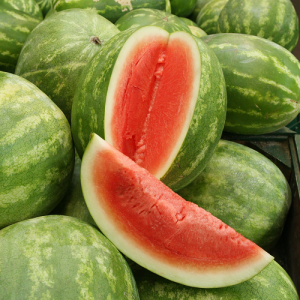 Oh, watermelon. How do I love thee? Let me count the ways.
Oh, watermelon. How do I love thee? Let me count the ways.
Watermelon is the perfect warm weather treat and a summer holiday essential. It’s a sweet, light, and delicious snack and its versatility lends itself to a wide variety of beverages, salads, meals, and desserts.
Watermelon is more than just water and sugar. It’s jam-packed with a number of vitamins and minerals that can help you stay healthy, including vitamin A, vitamin B6, vitamin C, potassium, and lycopene.
Vitamin A is vital to eye health and helps boost your immune system by supporting the functions of the infection-fighting white blood cells.
Vitamin B6 has many functions in the body, including aiding in immunity by supporting the creation of antibodies, which are needed to fight off infection. It also helps maintain proper nerve function and aids in the creation of red blood cells, which carry oxygen to all parts of the body. Vitamin B6 is also used to break down proteins into smaller parts that can be used to build and maintain muscle mass.
Vitamin C also helps boost immunity and overall cell health by helping to break down free radicals in the body, which can deteriorate cells over time.
Potassium is a mineral that is necessary for keeping a healthy water balance in the body, helping to maintain proper water balance and reducing the incidence of painful muscle cramps.
Lycopene is one of a family of vitamin precursors known as carotenoids. This substance is what helps give those bright red and pink fruits and vegetables – such as watermelon – their lovely color. Lycopene and other carotenoids function as antioxidants, which help eliminate those previously mentioned harmful free radicals. And preliminary studies have shown that lycopene may help reduce triglycerides and LDL cholesterol, which may lead to a reduction in cardiovascular disease risk.
Nearly every part of the watermelon can be eaten, from the sweet and juicy fruit to the rind, which is often pickled or used in stir frys. Even the fruit itself can be grilled and served as part of a savory dish. And watermelon is a sweet addition to many colorful summer salads.
One of my favorite watermelon recipes is a twist on a traditional favorite – Watermelon Lemonade – and is sure to be a great addition to any of your summertime picnics. Try it today!
Watermelon Lemonade
Ingredients
1/2 cup lemon juice
2 1/2 cups water
2/3 cups agave syrup*
2 cups watermelon chunks
*Other sweeteners may be used instead of agave syrup. However, be careful when adding them, as you may need to use less. Add to taste, mixing in a little at a time until you reach the desired sweetness.
Instructions
Place all the ingredients in a blender and blend until smooth. Serve over ice.
Servings
Makes about 5 cups.
Nutrition Facts
Serving size: 1 cup
Calories per serving: 163
Fat per serving: 0.3g
Saturated fat per serving: 0.0g
Fiber per serving: 0.3g
For more delicious recipes, please visit http://www.watermelon.org/Recipes.
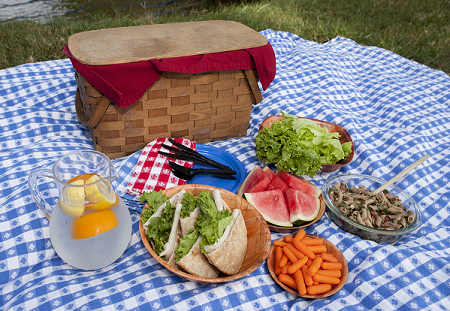
by Samantha Kennedy | Jun 27, 2017
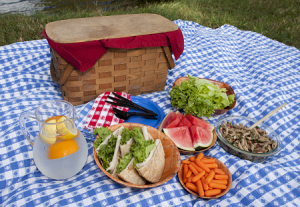 There are few things more iconic during summer than a picnic. There’s just something fresh and fun about sharing a meal in the park or at the beach with family and friends. But just because you’re enjoying the warm, gentle breeze doesn’t mean you should throw caution to the wind. By following a few simple food safety tips, you can ensure that your perfectly planned picnic doesn’t make you sick.
There are few things more iconic during summer than a picnic. There’s just something fresh and fun about sharing a meal in the park or at the beach with family and friends. But just because you’re enjoying the warm, gentle breeze doesn’t mean you should throw caution to the wind. By following a few simple food safety tips, you can ensure that your perfectly planned picnic doesn’t make you sick.
Planning it out. Not all foods are picnic-appropriate. Anything that requires a lot of perishable ingredients and/or a lot of preparation should be avoided. Stick with foods that require little or no cooking and that contain just a few ingredients. Foods such as fruits and vegetables (especially whole ones), hard cheeses, peanut butter and jelly, cereal, bread, and crackers are ideal picnic items. Anything made with commercially processed custard or mayonnaise will stay safe as long as they are kept cold.
Packing it up. Use a cooler, if possible, and store cold foods together so they can help each other stay colder longer. Use ice or frozen gel packs to help keep foods cold. Pack foods directly from the refrigerator into the cooler; don’t leave them sitting out before packing. Store ready-to-eat foods separately from raw meats. If packing up hot foods, be sure to keep them in a thermos or other insulated dish. DO NOT store them in the same container as the cold foods. Paper towels, disposable utensils, and a food thermometer are ideal picnic accessories. Remember, keep cold foods below 41 degrees F and hot foods above 135 degrees F. Do your best to keep the cooler away from direct sunlight by storing it in the shade and be sure to replenish the ice and/or frozen gel packs when they melt. Consider packing drinks in a separate cooler, as they are consumed more frequently; this will reduce the exposure of food items to warm air until you’re ready to eat.
Preparing the feast. All food items should be kept at the proper temperature at all times. When cooking raw meats, use separate plates for the raw and cooked products and clean and sanitize utensils between uses. Cook meat to the proper recommended internal temperature to ensure doneness and safety. Click here for a list of recommended internal cooking temperatures.
Presenting the bounty. Discard any perishable foods that have been left out for longer than two hours. In really hot weather (generally above 90 degrees F), foods should not be left out longer than one hour. Keep food protected in storage containers such as coolers and lidded dishes to minimize contamination from flies and other pests. Serve small portions of food at a time and keep the rest in the cooler.
Picnics are an important part of summer and with just a little bit of planning and a few useful tips and tools, they can be safe and delicious for everyone!
Source: Beaugh, Kristina. “Checklist for the Perfect Summer Picnic,” Foodsafety.gov blog, June 16, 2015. URL: https://www.foodsafety.gov/blog/2015/06/picnic.html.
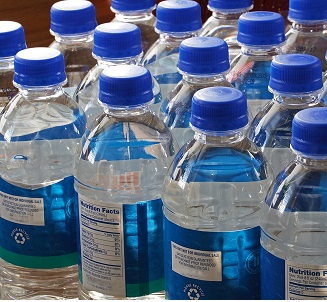
by Dorothy C. Lee | Jun 27, 2017

Carry water with you to sip throughout the day
Summer has arrived! During the summer months, especially along the Gulf Coast, it is hot and humid. Keeping the body hydrated is important to maintaining good health.
As the temperature rises in the summer and the body loses more water through evaporation and perspiration, it makes good sense to increase your intake of fluids. Keep in mind that by the time you notice you are thirsty, you have already depleted your water stores dramatically. A good rule of thumb is to drink a few ounces of water every fifteen to thirty minutes when you are working or playing hard in the heat.
- Myth or Fact – You should drink at least eight glasses of water a day.
Myth – On average, the body requires a half gallon of water daily. That’s the amount required to replace what has been lost through perspiration, evaporation, and body waste. Milk, juice, and other fluids can be added to your daily total. Beverages that contain caffeine, such as coffee, tea, and soft drinks, are not good substitutes for water. Caffeine actually may cause the body to lose water. The same is true for alcoholic beverages. They contribute to water loss, not gain, because alcohol acts as a diuretic.
- Myth or Fact – All water is the same.
Myth – The following guide will help you navigate the sea of choices available:
- Distilled Water – is pure water with no added chemicals or minerals.
- Mineral Water – is available in canned or bottled varieties. Many brands include a mix of minerals to improve the taste. Natural or artificial flavors, such as lime or lemon, may be added to some. Some varieties add sugar. Check the label.
- Soft Water– commercially softened water often is treated with salt and tends to be high in sodium.
- Sparkling Water– some sparkling waters contain bubbles naturally; others are created with the addition of carbon dioxide.
- Well Water – is more commonly known as tap water.
- Myth or Fact – Increasing daily water and fluid intake is difficult.
Myth – Actually, there are a variety of ways to increase water and other fluid intake. Purchase a insulated water bottle and refill it throughout the day. Add flavor to water. Infused water is becoming a popular food trend. Infuse with strawberries, lemons, limes, or other flavorful fruits and vegetables. Choose foods that contain high levels of water content – for example, watermelon, grapes, and kiwi. Start the day with a glass of water at breakfast.
- Myth or Fact – Water aids in bodily functions.
Fact – Water contributes about sixty percent of an adult’s body weight. Staying hydrated may be a major benefit to increasing energy production. Increased water consumption can aid in weight loss. Water aids in the body’s temperature regulation, acts as a lubricant, and cushions around joints. Water serves as a solvent for minerals, vitamins, amino acids, and glucose. Because water is vital to bodily functions, the body directs many of its activities toward maintaining balance.
- Myth or Fact – You can drink too much water.
Fact – Over-hydration can result in water intoxication. Water intoxication occurs when you consume more water than the kidneys can excrete. Consuming large amounts of water in a short period of time can result in intoxication. Remember, you should drink at least eight glasses of water a day – it’s a fact.
Reference: https://authoritynutrition.com/7-health-benefits-of-water/
by Laurie Osgood | Jun 11, 2017
Staying Healthy At Summer Camp – 7 Keys to a Healthy Camp Counselor Experience
It’s getting hot outside and that means summer camps are heating up! Being a camp counselor is a fun summer job and it’s a great way to learn leadership skills. As a camp counselor, it is your job to take care of the children that are under your supervision, but your own health and well-being is as important as the campers. If you’re not healthy, you won’t be able to properly care for the campers.

Here are 7 keys to staying healthy throughout your summer at camp:
- DRINK PLENTY OF WATER : When working outside in the summertime, it is essential for you and your campers to stay hydrated and avoid developing heat-related illnesses. The Center for Disease Control (CDC) https://www.cdc.gov/nutrition/data-statistics/plain-water-the-healthier-choice.html recommends between 6 to 8 glasses of water daily for good hydration. However, the amount of water that your body needs should be based on your individual need. Some of the symptoms of dehydration are: Mouth Dryness, Fatigue, Headache, Lightheadedness, Dizziness and Thirst. If you or a child in camp shows signs of any or all of these symptoms, immediately seek medical attention
- GET SOME SLEEP: Everyone feels a lot better after a good night’s sleep. One of the most critical threats to wellness for camp staff members is sleep deprivation. It’s easy to burn the candle at both ends when you’re working at a summer camp. Try to stick to your normal bedtime whenever possible. Routine is important for a good night’s sleep!
- EAT HEALTHY: During the hectic pace of summer camp, it is easy to forget to eat properly. What you eat can determine how well your body is fueled and how efficiently it functions. The MyPlate https://www.choosemyplate.gov/MyPlate guidelines call for making half your plate fruits and vegetables as part of a balanced meal. Eating a balanced diet is important for good health and increased energy, especially when working with campers.
- HANDWASHING & FOOD SAFETY: Bacteria and germs are hiding anywhere: in your kitchen, on your plate and even on your hands! It is important to wash your hands and hard surfaces often. Make sure to wash your hands with soap and warm water for 20 seconds before and after handling food. Foodborne bacteria can’t be seen, smelled or tasted, but they can make you sick! Therefore it is important to practice good food safety and food preparation practices. When in Doubt, Throw it out!
- SUN SAFETY: While enjoying the sun and outdoors, protect yourself from overexposure to sunlight by wearing a hat and using sunscreens. Severe sun burns (also known as sun poisoning) can also lead to extreme dehydration for you and your campers. Applying a broad-spectrum sunscreen (UVA/UVB), and re-applying every 2 hours or after swimming will help prevent a sunburn. As a camp counselor, you should remind kids to play in shaded areas to reduce their exposure to UV rays, especially between the hours of 10 AM and 4 PM, when the sun’s UV rays are at their peak.
- BUGS AND TICK BITE PREVENTION: Bugs and summer go together. To avoid getting bug bites, you should apply insect repellant that contains DEET to exposed skin, and wear long sleeves, pants, and other light-colored clothing. Campers should also try to avoid areas where ticks can be found, such as high grass and wooded areas. Campers should check for ticks every day, and remove them right away. Tick bites can lead to Lyme disease, which is particularly dangerous in the summer.
- STRESS MANAGEMENT: Stress can occur when we feel overloaded or under pressure in a demanding situation. Stress is a common problem among camp counselors. Managing your stress level is just as important as maintaining your physical health. Even though stress can be uncomfortable, it’s not always a bad thing, some stress can be a good thing and can help us better handle difficult situations.
As a camp counselor it is vital that you learn to relax, eat right, stay hydrated, and make sleep a priority, wash your hands, protect yourself from the sun, and take care of yourself!
Extension is a great resource for tips to stay healthy during the summer. You can find fact sheets and more information in our Electronic Data Information Source (EDIS) publications: http://edis.ifas.ufl.edu/
by Dorothy C. Lee | Jun 11, 2017
June is National Dairy Month. National Dairy month was first celebrated in 1937 to encourage Americans to drink more milk.
Milk and dairy products comprise a diverse group of foods from fluid milks, fermented milk products, and over 500 cheeses.
Generations of American children have grown up hearing the same parental advice, “Drink your milk…..milk builds strong bones and teeth.”
Milk has long been associated with good health, making it one of the heathiest beverages consumed in the United States. Current Dietary Guidelines recommend daily consumption of dairy for greatest impact. The body requires essential nutrients to maintain optimal health. Milk and dairy products are rich in many of these nutrients. Milk and dairy products contain calcium, vitamins A, D, B12, and high quality protein. The body absorbs calcium with the aid of vitamin D, both of which are found in fluid dairy products. Milk, whole, low fat, and skim, are homogenized and vitamin D fortified.
The amount of consumption from the dairy food group depends on age. Generally one cup of milk, yogurt, or one and a half ounces of cheese is considered a serving from the dairy group.
The cost of milk and dairy products varies. Careful selection can result in substantial savings. Milk generally is less expensive as a source of calcium than other dairy products.
Effective shopping skills depend on understanding and using information on the label including nutrition facts, product date, contents and ingredient statements. Usually larger containers, such as half gallon to a gallon cost less than single quarts. Compare the cost of the number of servings.
Milk and dairy products are highly perishable, so careful handling and storage to prevent spoilage, preserve flavor and retain nutritional uniformity is needed.
Florida regulations call for uniform standards for dating milk and requires all dairy processors to label milk and dairy product containers with the last date the product can be offered for sale. The date on the container does not mean that the milk will be spoiled on that date; it indicates that the milk should not be sold beyond that date. This is to insure a reasonable shelf life in your refrigerator after it is purchased. The quality and flavor are still dependent upon careful handling and storage. Remember, milk and dairy products are highly perishable and should be kept cold.
In recent years many kinds of alterative milk products have appeared in the market place. In choosing a dairy milk or dairy alternative you should be aware of the different alternative milk products available and what makes them different. With so many kinds of milk and milk alternatives on the market, reading the labels on containers to recognize differences in the contents is well worth while. Here is information on some of the more popular forms of milk alternatives now available and an explanation of some special terms you may find on labels and facts that may help in buying.
-
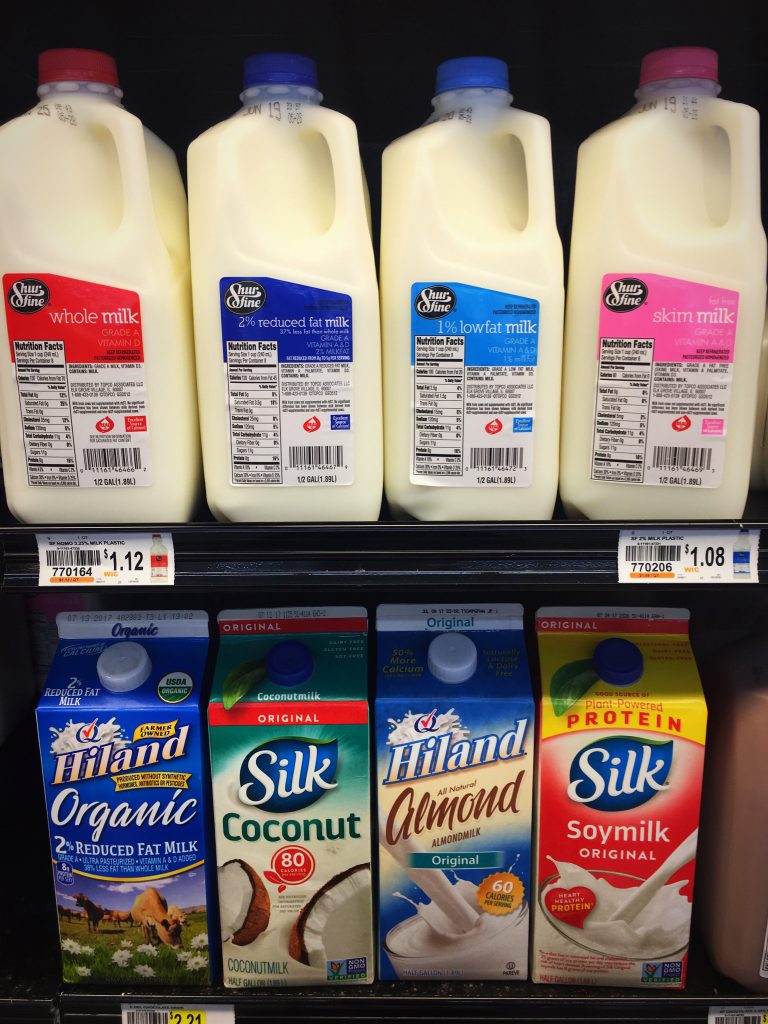
Variety of milks Picture by Wendy Meredith
Almond
- Low-fat
- 40 calories
- 1 gram protein
- Low in protein or calcium content. Nutty flavor.
- Coconut
- 420 calories per cup
- 3 grams protein
- 45 grams fat
- High in fat content.
- Hemp
- Made from hemp seeds
- Contains 10 essential amino acids
- 80-140 calories per cup
- 3 grams protein
- Grassy flavor. Tends to separate when added to hot beverages.
- Rice
- 130 calories per cup
- 1 gram protein
- 2 grams fat
- Low in fat and protein content. Higher in carbohydrates.
- Soy
- 110 -130 calories per cup
- 7-11 grams protein
- 4 grams fat
- Higher in protein content. Thick texture often taste.
There are many ways to add milk into meals. Many people find milk refreshing and never tire of drinking it plain. However, cooked foods and other prepared foods offer many additional ways to add more milk into daily food, always with much added nutritive value and often extra dividends in flavor. Use milk instead of water when preparing cooking cereal, or add milk when preparing soups, mashed potatoes, custards sauces and other cooked foods. Beverages made with milk or milk products fit into meals and snacks and add extra nutritive values to daily fluid intake.
June is National Dairy Month, but milk is needed for good health every day of the year.
References;
https://www.ams.usda.gov/about-ams/programs-offices/dairy-program
https://www.choosemyplate.gov/
https://health.gov/DietaryGuidelines/
For further information, contact:
Dorothy C. Lee, C.F.C.S.
UF/IFAS Extension Escambia County
3740 Stefani Road
Cantonment, FL 32533-7792
(850) 475-5230








